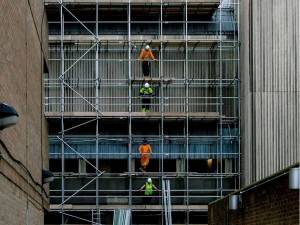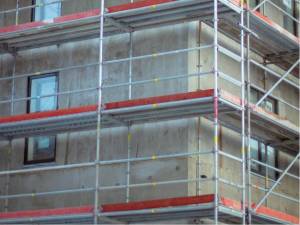
Scaffolding is vital for the maintenance and construction industry, offering support for tasks at heights but also poses risks. Ensuring scaffolding safety tips is crucial to prevent accidents and protect workers.
Main Hazards of Scaffolding
The most significant hazards associated with scaffolding include falls and collapses, falling objects, electrocution, and structural instability. Scaffolding accidents can result in severe injuries or even death.
- Falls from heights are the primary cause of injuries and fatalities in scaffolding work. Such falls often occur due to inadequate guardrails, safety harnesses, or nets.
- Scaffolding collapses can result from improper assembly, overloading, or structural failures.
- Falling objects, such as tools and debris, present significant risks to workers below.
- Electrocution hazards arise when scaffolds are placed too close to power lines.
- Wet or uneven platforms can lead to slips, trips, and missteps, causing injuries to workers.
Scaffolding Safety Requirements

Proper planning and adherence to scaffolding safety measures can prevent accidents and ensure the safety of workers on scaffolding.
Stable Foundation
- Stable Ground: Ensuring that scaffolding is erected on a solid, level foundation is crucial to prevent shifting or collapse. The ground should be compact and capable of supporting the scaffold’s weight.
- Base Plates and Mud Sills: Use baseplates and mud sills to distribute the scaffold’s weight evenly. Base Plates provide a flat, stable surface, while mud sills help to spread the load over a larger area, reducing the risk of sinking or tilting.
- Proper Assembly: Follow the manufacturer’s instructions meticulously during assembly. This includes using the correct components and ensuring all connections are secure. Proper assembly is vital to the scaffold’s structural integrity.
Daily Checks
- Regular Inspections: Conduct daily inspections of the scaffolding to check for any signs of wear, damage, or instability. Look for issues such as bent or broken scaffolding components, loose materials connections, and signs of rust or corrosion.
- Qualified Inspectors: Ensure that inspections are carried out by qualified personnel who are trained to identify potential hazards and necessary repairs. Inspectors should have a thorough understanding of scaffolding safety standards and best practices.
- Documentation: Keep detailed records of all inspections and any maintenance performed. This documentation helps ensure accountability and provides a reference for future inspections and audits.
Safe Ladders or Stairs
- Safe Access: Provide safe and secure ladders or stairs for workers to access different levels of the scaffold. These access points should be designed to prevent falls and facilitate easy movement.
- Clear Pathways: Ensure that access points are free from obstructions and hazards. Workers should be able to move up and down the scaffold without encountering obstacles that could cause trips or falls.
- Proper Installation: Install ladders and stairs according to safety standards. This includes securing them firmly to the scaffold and ensuring they are of adequate strength and stability.
Avoid High Winds or Storms
- Weather Monitoring: Regularly monitor weather conditions and avoid using scaffolds during high winds, storms, or other adverse weather conditions. High winds can cause scaffolds to sway or collapse, while rain can make platforms slippery.
- Securing Scaffolds: Secure scaffold structure during inclement weather to prevent them from being blown over or damaged. This may involve tying the scaffold to a stable structure or using additional bracing.
- Temporary Suspension: Suspend work on scaffolds if weather conditions pose a risk to worker safety. Workers should be instructed to leave the scaffold and seek shelter until conditions improve.
Never Overload the Scaffold
- Weight Limits: Adhere to the scaffold’s weight capacity, considering the combined weight of workers, tools, and materials. Overloading can cause the scaffold to collapse or become unstable.
- Load Distribution: Evenly distribute loads to prevent tipping or collapse. Heavy materials should be placed close to the scaffold’s supports, and loads should be balanced to avoid uneven stress.
Ensure Guardrails, Toe boards, and Midrails Are in Place
- Guardrails: Install guardrails on all open sides and ends of the scaffold to prevent falls. Guardrails should be at least 38 inches high and capable of withstanding a force of at least 200 pounds.
- Toe boards: Use toe boards to prevent tools and materials from falling off the scaffold. Toe boards should be at least 3.5 inches high and securely attached to the scaffold.
- Midrails: Ensure midrails are installed to provide additional fall protection. Midrails should be placed halfway between the guardrail and the platform.
Maintain a Clear Distance from Power Lines
- Safe Distances: Maintain a safe distance from power lines, following local regulations and guidelines. The minimum safe distance varies depending on the voltage of the power lines, but is typically at least 10 feet.
- Electrical Safety: Use non-conductive materials and take precautions to avoid contact with electrical sources. Workers should be trained to recognise electrical hazards and know how to work safely around them.
Only Competent Person Should Assemble or Dismantle Scaffolds
- Qualified Personnel: Ensure that only trained workers are involved in the assembly, inspection, and dismantling of scaffolds. These workers should have received formal training in scaffold safety and be familiar with the specific type of scaffold being used.
- Training Programs: Provide proper training programs to keep workers updated on the latest safety practices and regulations. Training should cover topics such as hazard recognition, fall protection, and emergency procedures.
Supervision: Supervisors should oversee scaffold assembly and dismantling to ensure compliance with safety standards. They should also be available to answer questions and address any safety concerns that arise.
Scaffolding from Asia Warehouse

Scaffolding safety is both a regulatory and moral duty to protect workers. Prioritising safety and regular inspections can prevent accidents, reduce downtime, and promote a responsible work culture. Companies and workers must stay vigilant and committed to high safety standards.
Asia Warehouse prioritises scaffolding safety with a range of high-quality products meeting stringent standards. Our durable and easy-to-assemble scaffolding solutions enhance safety and efficiency on any project. Visit our website or contact us to learn how we can help you build a safer worksite.
